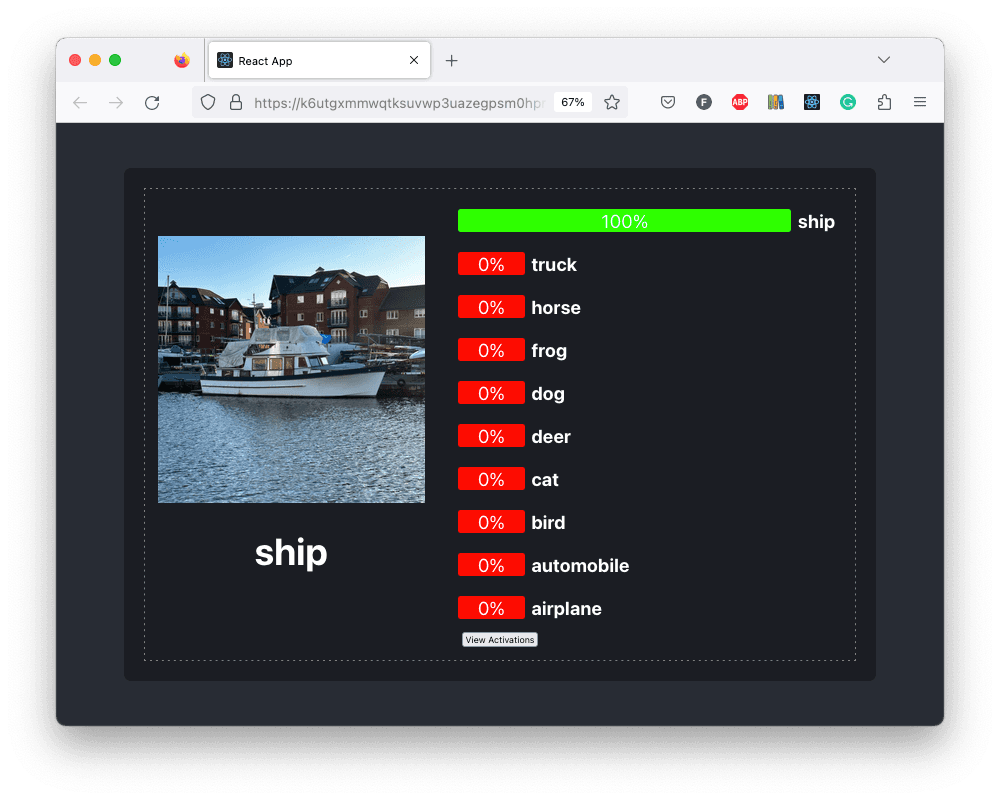![[object Object]](/_next/image?url=https%3A%2F%2Fcdn.sanity.io%2Fimages%2Fei1axngy%2Fproduction%2F957989365a62cbae07e332d2965c44dccbe16b0e-490x490.jpg&w=256&q=75)
by Dr Freddy Wordingham
Updated 30 November 2023
Using TensorFlow to Build a Production-Ready Neural Network-Powered Web App
Course Description
In this course we're going to combine machine learning and web development to build a full-stack image classifier web app. We'll train a convolutional neural network (CNN) to classify images, and then build a web app to serve it to users. We'll use FastAPI for our backend, React for our frontend, and AWS Lambda for our infrastructure.
Building machine learning models is only half the battle. We also need to be able to deploy them to users. This is where web development and dev ops come in. In this course we'll be covering all of the fundamentals necessary to allow you to unlease you AI models to the world.

🗺 The Plan
We're going to build our application over twelve core "chapters":
- Overview
- Project setup
- Training a CNN
- Classifying an image
- Visualising the model
- More training
- Building a UI
- Serving our application
- Calling our backend, from the frontend
- Classifying an image with the UI
- Deploying our app as a serverless image
- Adding prediction bar chart
- Adding model visualisations
- Refactor
- Optimise!
For reference, each chapter will contain a copy of the source code as it evolves with the project.
Ideally, build your own version as you follow through. If you want to get the most out of it, play about with the project after the end of each chapter by trying to add new features, optimisations or refactorings.
📚 The Stack
"The Stack" is the set of technologies used to build and run a software application.
It's usually divided into:
- Frontend: The client-side interface (e.g., React)
- Backend: Server-side logic and databases (e.g., FastAPI, SQL)
- DevOps: Infrastructure and deployment (e.g., AWS Lambda, Docker)
Ideally, we want to choose a stack which is performant, scalable, and easy to develop with.
🖥️ Frontend
The frontend is where we'll display our application to the user.
Whilst we could write our own HTML, CSS, and JavaScript, it's much easier to use a framework.
We're going to use React for our frontend, as it's one of the most popular (well supported and used) frontend frameworks.
At the cost of a slightly higher learning curve (than raw HTML, CSS and JS), it's also one of the most performant and allows us to keep our code clean and modular.
⚙️ Backend
The backend is where we'll run the machine learning model, and serve it the information to the frontend to be displayed.
We're going to use Python for our backend, as it's the most popular language for machine learning.
And it has some great libraries for web-servers, such as FastAPI.
Although we could use a traditional web-server, such as Flask, we're going to use FastAPI as it's a newer framework which has some benefits such as:
- Speed: FastAPI is faster than Flask, thanks to Starlette and Pydantic.
- Type Checking: Automatic request validation via type hints.
- Auto Docs: Swagger and ReDoc integrated out-of-the-box.
- Async Support: Native support for asynchronous programming.
- Modern: Built-in support for data validation, OAuth2, and more.
- Dependency Injection: Simplifies complex use-cases by providing shared components.
FastAPI can be particularly beneficial for ML and data-heavy apps due to its performance and async capabilities. For simple projects, Flask might still be sufficient.
🌐 DevOps
Developer Operations (DevOps) is the process of managing the development and deployment of software.
As we mentioned earlier, we need a stack architecture which is scalable, performant, and easy to develop with. Serverless is a great choice for this, as it's easy to deploy, and scales automatically. We also don't have to worry about managing servers, which is a huge plus. And we'll only pay for what we use!
Note: "Serverless" doesn't mean there are no servers. It just means we don't have to worry about them.
We're going to use AWS Lambda to deploy our backend.
We could create the lambda with a .zip file, but we'll have higher memory limits using Docker images.
🧰 You will need:
To follow along with this project, you must have:
- A computer with a terminal (e.g., iTerm, PowerShell)
- An editor (e.g., VSCode)
- A web browser (e.g., Chrome)
- An AWS account
You do not need these to create this project, but they will make your life easier:
- Git (for version control)
- A GitHub account (for hosting your code)